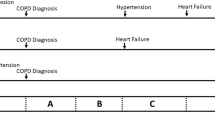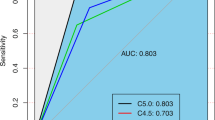Abstract
Chronic obstructive pulmonary disease (COPD) has a rising global incidence and acute exacerbation of COPD (AECOPD) carries a high health-care economic burden. Classification and regression tree (CART) analysis is able to create decision trees to classify risk groups. We analysed routinely collected laboratory data to identify prognostic factors for inpatient mortality with AECOPD from our large district hospital. Data from 5,985 patients with 9,915 admissions for AECOPD over a 7-year period were examined. Randomly allocated training (n = 4,986) or validation (n = 4,929) data sets were developed and CART analysis was used to model the risk of all-cause death during admission. Inpatient mortality was 15.5%, mean age was 71.5 (±11.5) years, 56.2% were male, and mean length of stay was 9.2 (±12.2) days. Of 29 variables used, CART analysis identified three (serum albumin, urea, and arterial pCO2) to predict in-hospital mortality in five risk groups, with mortality ranging from 3.0 to 23.4%. C statistic indices were 0.734 and 0.701 on the training and validation sets, respectively, indicating good model performance. The highest-risk group (23.4% mortality) had serum urea >7.35 mmol/l, arterial pCO2 >6.45 kPa, and normal serum albumin (>36.5 g/l). It is possible to develop clinically useful risk prediction models for mortality using laboratory data from the first 24 h of admission in AECOPD.



Similar content being viewed by others
References
(2008) Deaths from chronic obstructive pulmonary disease—United States, 2000–2005. MMWR Morb Mortal Wkly Rep 57:1229–1232
British Thoracic Society (2006) The burden of lung disease: a statistical report from the British Thoracic Society, 2nd edn. British Thoracic Society, London
Roche N, Zureik M, Soussan D, Neukirch F, Perrotin D (2008) Predictors of outcomes in COPD exacerbation cases presenting to the emergency department. Eur Respir J 32:953–961
Faustini A, Marino C, D’Ippoliti D, Forastiere F, Belleudi V, Perucci CA (2008) The impact on risk-factor analysis of different mortality outcomes in COPD patients. Eur Respir J 32:629–636
Dransfield MT, Rowe SM, Johnson JE, Bailey WC, Gerald LB (2008) Use of beta blockers and the risk of death in hospitalised patients with acute exacerbations of COPD. Thorax 63:301–305
Gunen H, Hacievliyagil SS, Kosar F et al (2005) Factors affecting survival of hospitalised patients with COPD. Eur Respir J 26:234–241
Mannino DM, Buist AS, Petty TL, Enright PL, Redd SC (2003) Lung function and mortality in the United States: data from the First National Health and Nutrition Examination Survey follow up study. Thorax 58:388–393
Tu JV (1996) Advantages and disadvantages of using artificial neural networks versus logistic regression for predicting medical outcomes. J Clin Epidemiol 49:1225–1231
Hosmer DW, Lemeshow S (2000) Applied logistic regression, 2nd edn. John Wiley & Sons, New York
Hasford J, Ansari H, Lehmann K (1993) CART and logistic regression analyses of risk factors for first dose hypotension by an ACE-inhibitor. Therapie 48:479–482
Hess KR, Abbruzzese MC, Lenzi R, Raber MN, Abbruzzese JL (1999) Classification and regression tree analysis of 1000 consecutive patients with unknown primary carcinoma. Clin Cancer Res 5:3403–3410
Rainer TH, Lam PKW, Wong EMC, Cocks RA (1999) Derivation of a prediction rule for post-traumatic acute lung injury. Resuscitation 42:187–196
Spurgeon SEF, Hsieh Y-C, Rivadinera A, Beer TM, Mori M, Garzotto M (2006) Classification and regression tree analysis for the prediction of aggressive prostate cancer on biopsy. J Urol 175:918–922
Seemungal T, Donaldson G, Bhowmik A, Jeffries D, Wedzicha J (2000) Time course and recovery of exacerbations in patients with chronic obstructive pulmonary disease. Am J Respir Crit Care Med 161:1608–1613
Prytherch D, Sirl JS, Weaver PC, Schmidt P, Higgins B, Sutton GL (2003) Towards a national clinical minimum data set for general surgery. Br J Surg 90:1300–1305
Breiman L, Friedman J, Olshen R, Stone C (1984) Classification and regression trees. Chapman & Hall CRC Press, Boca Raton, FL
Ai-Ping C, Lee KH, Lim TK (2005) In-hospital and 5-year mortality of patients treated in the ICU for acute exacerbation of COPD: a retrospective study. Chest 128:518–524
Fuso L, Incalzi RA, Pistelli R, Muzzolon R, Valente S, Pagliari G, Gliozzi F, Ciappi G (1995) Predicting mortality of patients hospitalized for acutely exacerbated chronic obstructive pulmonary disease. Am J Med 98:272–277
Murata GH, Kapsner CO, Lium DJ, Busby HK (1998) A multivariate model for predicting respiratory status in patients with chronic obstructive pulmonary disease. J Gen Intern Med 13:462–468
Weiss ST, DeMeo DL, Postma DS (2003) COPD: problems in diagnosis and measurement. Eur Respir J 21:4S–S12
Landbo C, Prescott E, Lange P, Vestbo J, Almdal TP (1999) Prognostic value of nutritional status in chronic obstructive pulmonary disease. Am J Respir Crit Care Med 160:1856–1861
Gray-Donald K, Gibbons L, Shapiro SH, Macklem PT, Martin JG (1996) Nutritional status and mortality in chronic obstructive pulmonary disease. Am J Respir Crit Care Med 153:961–966
Celli BR, Cote CG, Marin JM et al (2004) The body-mass index, airflow obstruction, dyspnea, and exercise capacity index in chronic obstructive pulmonary disease. N Engl J Med 350:1005–1012
Connors AF Jr, Dawson NV, Thomas C et al (1996) Outcomes following acute exacerbation of severe chronic obstructive lung disease. The SUPPORT investigators (Study to Understand Prognoses and Preferences for Outcomes and Risks of Treatments). Am J Respir Crit Care Med 154:959–967
Antonelli IR, Fuso L, De Rosa M et al (1997) Co-morbidity contributes to predict mortality of patients with chronic obstructive pulmonary disease. Eur Respir J 10:2794–2800
Marquis K, Debigare R, Lacasse Y et al (2002) Midthigh muscle cross-sectional area is a better predictor of mortality than body mass index in patients with chronic obstructive pulmonary disease. Am J Respir Crit Care Med 166:809–813
Rothman K, Greenland S (1998) Cohort Studies. In: Rothman K, Greenland S (eds) Modern epidemiology, 2nd edn. Lippincott-Raven, Philadelphia, pp 71–91
Meade M, Guyatt G, Cook D et al (2001) Predicting success in weaning from mechanical ventilation. Chest 120:400S–424S
Varela G, Novoa N, Jimenez MF, Santos G (2003) Applicability of logistic regression (LR) risk modelling to decision making in lung cancer resection. Interact Cardiovasc Thorac Surg 2:12–15
Birim O, Kappetein AP, Waleboer M et al (2006) Long-term survival after non-small cell lung cancer surgery: Development and validation of a prognostic model with a preoperative and postoperative mode. J Thorac Cardiovasc Surg 132:491–498
Esteban C, Quintana JM, Aburto M, Moraza J, Capelastegui A (2006) A simple score for assessing stable chronic obstructive pulmonary disease. QJM 99:751–759
Wildman MJ, Sanderson C, Groves J et al (2009) Predicting mortality for patients with exacerbations of COPD and Asthma in the COPD and Asthma Outcome Study (CAOS). QJM 102:389–399
Acknowledgments
We are grateful to the Departments of Clinical Coding, Cardiology, Haematology, and Biochemistry for providing the data and to Sumita Kerley for her assistance in data collection. This project was supported by a student bursary (for AA) from the University of Portsmouth.
Disclosure
All authors declare that there are no competing interests related to this manuscript.
Author information
Authors and Affiliations
Corresponding author
Additional information
A. C. Asiimwe and F. J. H. Brims are Joint first authors.
Rights and permissions
About this article
Cite this article
Asiimwe, A.C., Brims, F.J.H., Andrews, N.P. et al. Routine Laboratory Tests can Predict In-hospital Mortality in Acute Exacerbations of COPD. Lung 189, 225–232 (2011). https://doi.org/10.1007/s00408-011-9298-z
Received:
Accepted:
Published:
Issue Date:
DOI: https://doi.org/10.1007/s00408-011-9298-z




